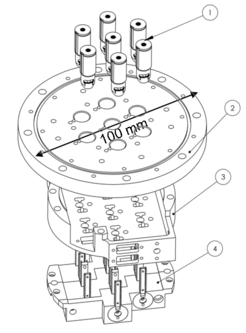SIS Mixer
The SIS mixers are developed by SRON-G, the SIS-Junctions are manufactured at the University of Delft. For the 660 GHz band a classical Nb-AlOx-Nb junction is used, while for the 850 GHz band a Nb-NbTiN-junction has been developed. All mixers are fixed-tuned double side-band waveguide devices with a commercial corrugated feed horn.

Mechanical Design
The SIS mixers for CHAMP+ have the same cylindrical envelope for both colors. It consists of a corrugated horn, made by RPG Meckenheim (Germany), and a back-piece that is held together by a phosphor copper nut which slots are made such that it presses the back-short cavity with constant force even when cooled to 4.2 K. The back-piece contains a fixed back-short cavity and a substrate channel machined across it. We use a reduced height waveguide with dimensions 400 × 100 μm for the low-frequency band and appropriately scaled dimensions for the higher frequency band.
A 40 μm thick quartz substrate is glued in the substrate channel by UV curing epoxy. The substrate contains the SIS junction and associated superconducting tuning elements to match the waveguide probe impedance to the impedance of the SIS junction and to provide choke filters for separating the RF and IF/DC signal. One side of the substrate is grounded to the body of the back piece and the other side is contacted to a central pin of a GPO-type IF connector. We use a limited detent connector at the mixer side and a smooth bore GPO connector at the IF/DC distribution board to be able to easily remove the mixer from the array frame by sliding it along the axis of the cylinder. This mechanical design is similar to the one used for the ALMA mixers.
The magnetic field that is required for mixer operation at higher frequencies, is applied to the junction by using cylindrical field conductors, which are mounted perpendicular to a substrate channel. These conductors are then contacted with the general magnetic field distribution using spring supported leaves. This arrangement allows to mount and dismount individual mixers without disassembly of the complete array block. The magnetic field itself is created by a superconducting coil. Each mixer has its own magnetic field coil to allow for independent adjustmen
